Aloe vera is one of the most beneficial plants to have in your garden or house. It is well-known for its low maintenance and its medicinal properties. But, seeing their fleshy leaves curl can be troublesome.
The leaves of your Aloe vera can curl due to dehydration. Too much sun, inadequate watering, wrong potting mix, and root rot can lead to a lack of moisture in the soil making the leaves curl inward. Check the soil before watering and provide adequate water to keep your aloe vera thriving.
If your Aloe leaves are curling, you must identify the problems and address them before it’s too late. This article will help you with all of that, so keep reading.
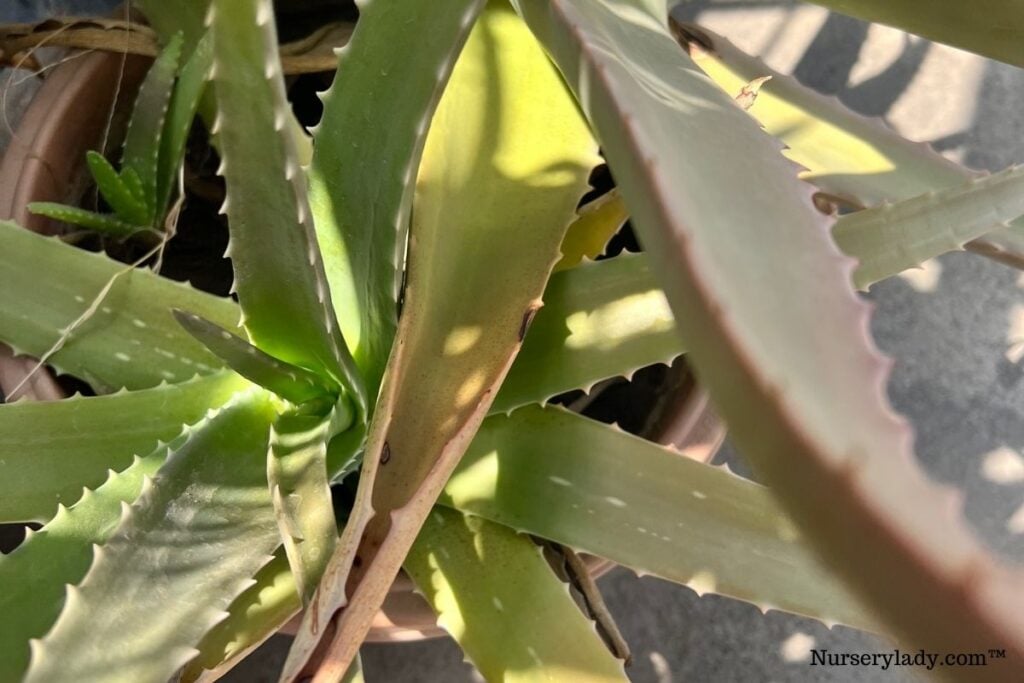
Reasons behind Aloe vera curling leaves
Aloe vera is a hardy succulent that thrives with minimal care, but without the correct conditions, the plant will develop various problems.
The possible reasons behind the curling leaves on your Aloe vera are:
- Too much sun
- Low light
- Drought stress
- Wrong soil
- Cold
- Root rot
- Diseases
Now let’s understand these in detail.
Too much sun
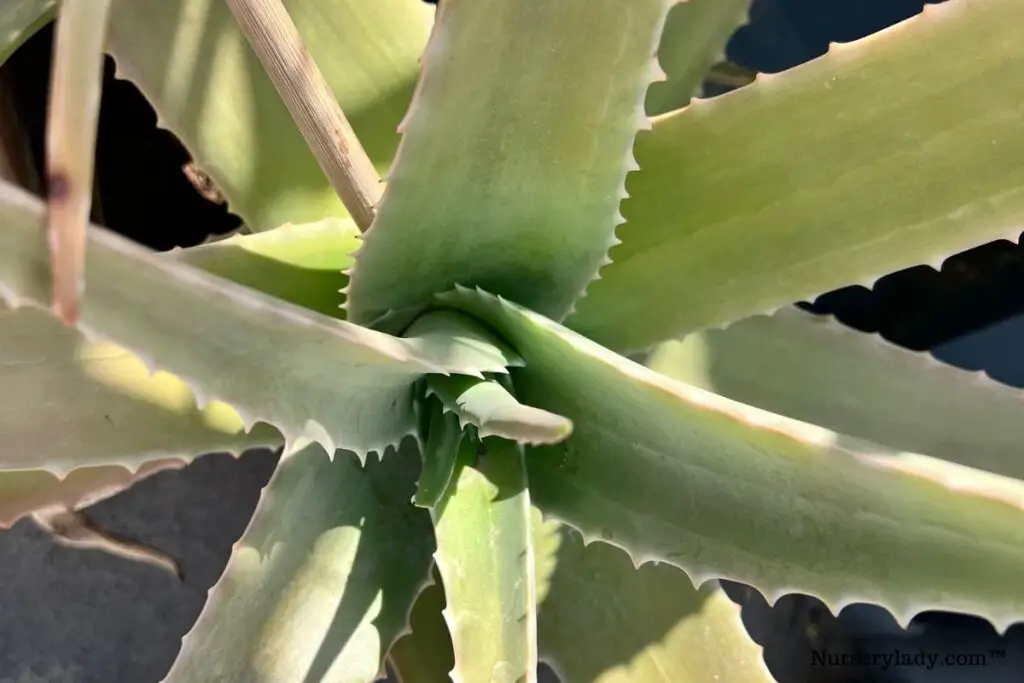
Aloe vera are succulents that love the sun and require 6 hours of full sun every day.
But what many people don’t note is that these plants are sensitive to excess or too intense sunlight.
If your Aloe is exposed to long hours of direct sunlight or the intense sunlight of summer afternoons, it will get stressed.
If you grow your Aloe vera outside, it can get exposed to excess direct sunlight, burning the leaves and dehydrating your plant.
Even the hot drafts can add to the stress and worsen the condition of your Aloe vera.
If this is the reason behind the curling of your Aloe leaves, you will notice that the leaves are curling inwards.
The leaves will also get discolored and start turning yellow.
Solution:
If you think your Aloe vera is getting too much sun:
- Relocate the plant to a spot where it will get full sun for 6 hours but stay protected from its intense rays.
- You can use blinds and curtains to protect the plant for your potted Aloe vera when the sunlight becomes too intense.
- If your Aloe vera grows in the garden, you can fix shading nets over it when the sunlight is too harsh.
- Give a good soak to the plant as intense sunlight dehydrates the plant, so it will require water to recover.
Also read: Aloe Vera Temperature Tolerance: Ideal Temperature+Keeping Them Safe
Looking for gardening supplies? We have tested 100's of products before recommending them to you guys. Check out our best pick below:
| Image | Gardening Supplies | Best Price? |
|---|---|---|
 Top
Top Top
Top | Raised Garden Bed Kit | Check On Amazon |
 | XLUX Soil Moisture Meter, Plant Water Monitor, Soil Hygrometer Sensor for Gardening, Farming, Indoor and Outdoor Plants, No Batteries Required | No Results |
 Top
Top Top
Top | 82 Pcs Garden Tools Set and Extra Succulent Tools Set | Check On Amazon |
 | Joeys Garden Expandable Garden Hose with 8 Function Hose Nozzle, Lightweight Anti-Kink Flexible Garden Hoses, Extra Strength Fabric with Double Latex Core, (50 FT, Black) | No Results |
 Top
Top Top
Top | Dual Chamber Compost Tumbler | Check On Amazon |
 Top
Top Top
Top | Sunnyglade Plant Stakes | Check On Amazon |
 Top
Top Top
Top | Organic Cold Pressed Neem Seed Oil | Check On Amazon |
 Top
Top Top
Top | Mighty Mint Gallon :-Insect and Pest Control Peppermint Oil | Check On Amazon |
 Top
Top Top
Top | Scotts DiseaseEx Lawn Fungicide | Check On Amazon |
 Top
Top Top
Top | Jacks Classic 20-20-20 All Purpose Fertilizer | Check On Amazon |
 Top
Top Top
Top | 30,000 Seeds Pollinator Attracting Wildflower Mixture | Check On Amazon |
 Top
Top Top
Top | Survival Vegetable Seeds Garden Kit-Over 16,000 Seeds | Check On Amazon |
Low light

As I already mentioned, Aloe vera loves full sun and requires 6 hours of direct sunlight every day.
But if you keep it or plant it in a low-light or shaded spot, it won’t remain healthy.
Without sufficient light, your Aloe will not be able to photosynthesize properly and run out of energy very soon.
Therefore, the leaves will not be able to hold themselves and start curling outwards.
Without enough light, the soil will remain soggy and invite pests and diseases to the plant.
Solution:
If your aloe vera is not getting enough light, find a better spot for it.
- Move the succulent to a bright spot where it can get 6 hours of direct sunlight. You can place it in a South-facing window, but you will have to protect it when the sunlight gets intense in the afternoons.
- If your Aloe is growing the garden, you can dig it out and find a planting site that doesn’t have any tall trees or walls that block the sunlight from reaching the plant.
- If your house doesn’t get enough natural light, take the help of artificial lights or LED lights.
Also read: What Kind Of Light For Aloe Vera Plants? (Full sun, Shade, Or Partial Light?)
Drought stress
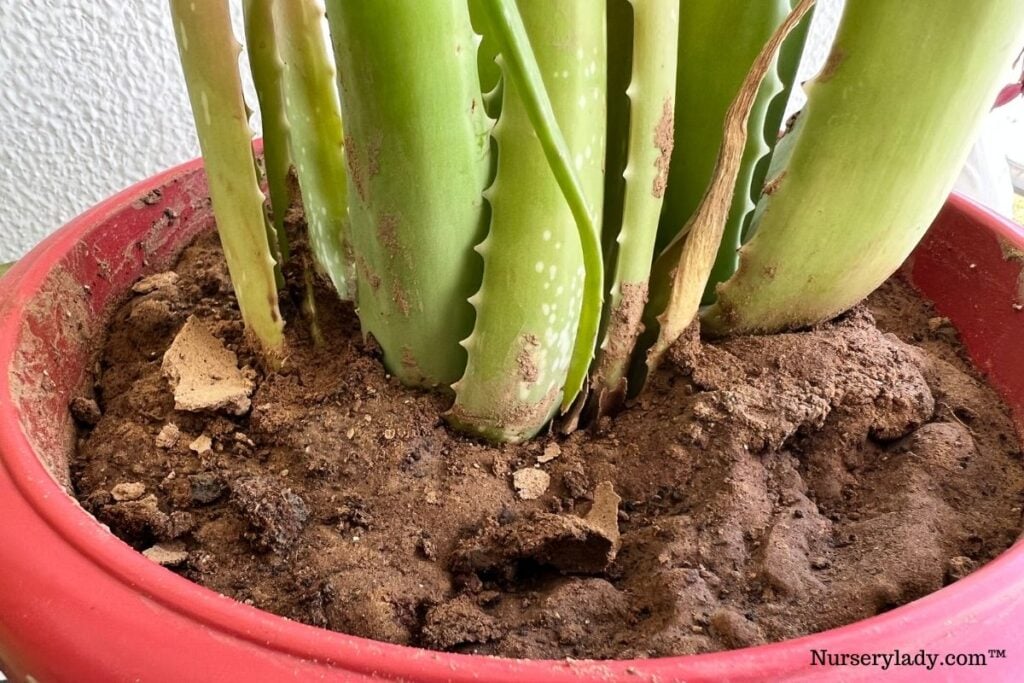
Aloe vera usually does well in dry conditions, but that doesn’t mean the plant will not require any water.
If you forget to water your Aloe vera on time, it experiences a drought-like situation that becomes very stressful for it.
It uses up the water that it stores in its leaves, and the leaves start curling inwards and becoming thin.
An aloe vera doesn’t experience drought stress only due to underwatering, and there might be many other reasons that come to play.
Maybe you are watering your Aloe vera but not thoroughly.
You are watering the plant lightly, so it is screaming for water much before it should.
Other reasons can include:
- Your aloe vera is getting excess sunlight.
- The water is draining water too fast.
- Your potted aloe vera is placed near a heating source that is dehydrating it.
- Your aloe vera is staying thirsty for too long.
- Or the Aloe is not receiving sufficient humidity.
All of these reasons together or individually might be responsible for causing the leaves to curl on your Aloe vera.
Solution:
- You must water your Aloe vera whenever the soil goes dry. Usually, an aloe vera requires watering every 2-3 weeks during its growing season.
- Avoid watering it lightly as it needs enough water to sustain it for 2-3 weeks before the next watering. For potted Aloe veras, water till it starts running out of the drainage holes.
- Although Aloe vera doesn’t need any extra humidity, exposing it to drafts or the direct air of the AC can reduce the humidity to an extent where the plant experiences drought stress.
- Don’t keep your Aloe too close to the fireplace, furnace, radiator, or other heating sources, as the high temperatures will dehydrate the plant.
- You must use well-drained soil for Aloe vera, but it shouldn’t be so loose that it can’t hold the required moisture.
Also read: How To Water Aloe Vera Plant? (How often, Summer, Winter)
Wrong soil
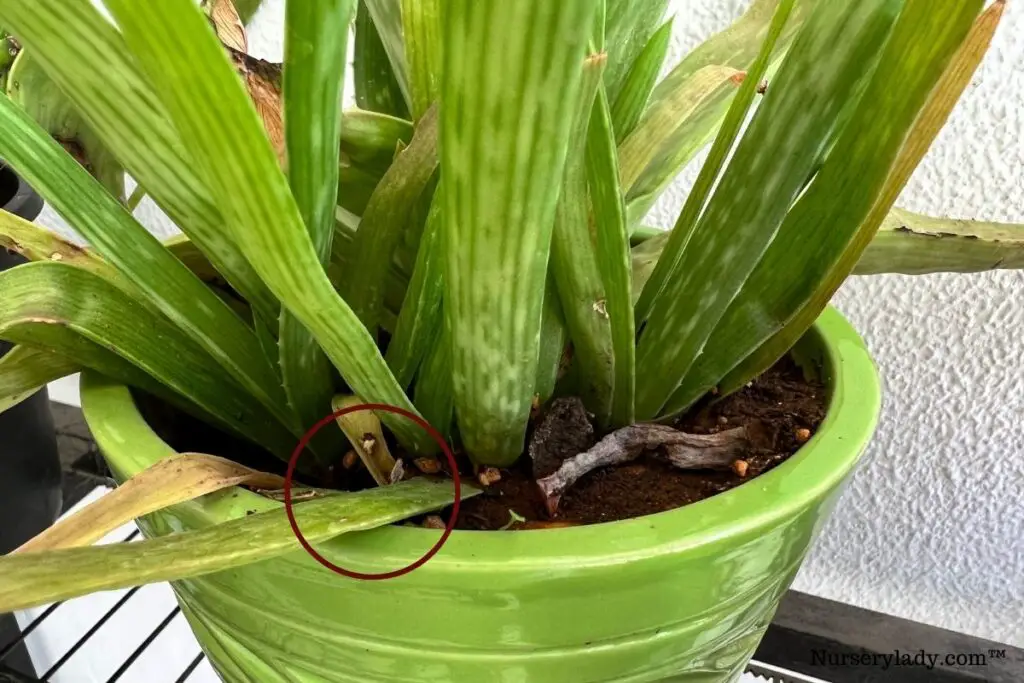
Aloe vera will not survive in any soil type.
If you use the incorrect soil, the Aloe vera will develop different problems, including curling leaves.
First of all, Aloe vera doesn’t need nutrient-rich soil that retains water very well.
This soil type is ideal for moisture-loving tropical plants but not succulents like Aloe vera.
If you plant your Aloe vera in such soil, the roots will receive excess moisture and experience overwatering.
This will weaken the plant, and the leaves will curl and become soft.
The common mistake nurseries make planting the Aloe in peat-based soil.
They do this because it is light and drains water fast.
But if the soil dries up completely, it becomes water-resistant.
You might water and watch the water drain out of the holes, but the water runs down the pot’s walls instead of getting absorbed by the soil.
The roots fail to receive any water, and therefore, the leaves curl due to lack of water.
Solution:
The solution is to take your Aloe from its current spot or planter and prepare suitable soil.
You can either use a pre-made succulent or cactus mix or prepare the soil by mixing:
The potting soil will provide enough nutrients to your Aloe vera.
Perlite will help the soil remain loose and allow proper airflow, while sand improves the drainage.
Also read: What Type Of Soil For Aloe Vera Plant? (+Ideal Soil Mix)
Cold
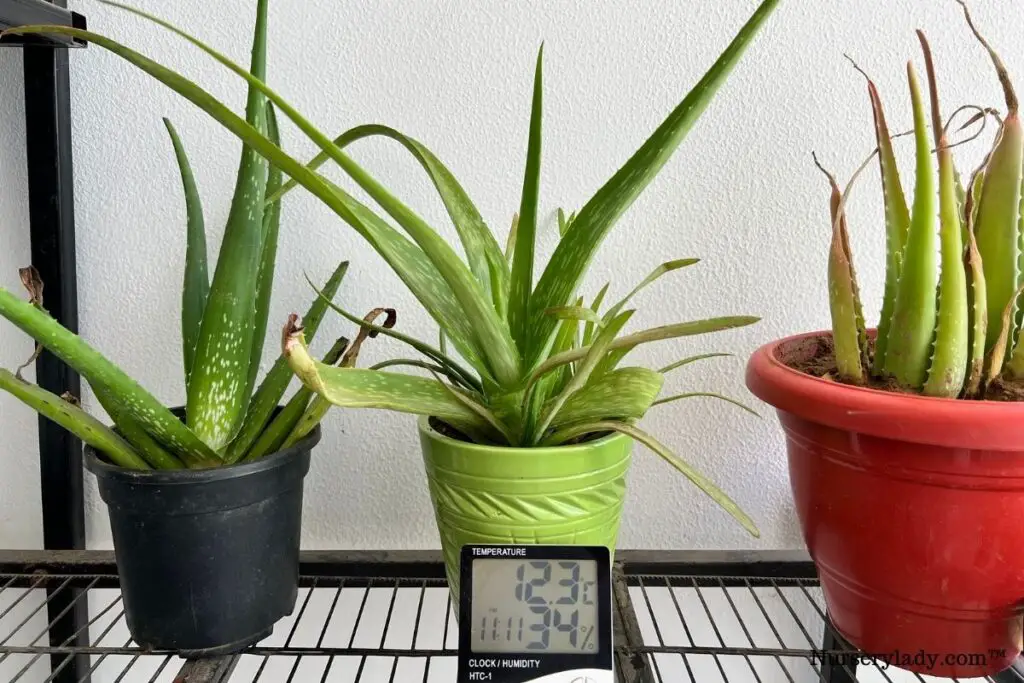
Aloe vera are succulents that prefer warm conditions and are sensitive to cold.
So, if you notice that the Aloe leaves are curling, the chances are that the plant might have experienced a cold shock.
If your Aloe grows outside, the temperatures might drop below 50°F at night, unsuitable for this species.
The temperatures also drop during the winter season and become unbearable for the Aloe.
Even potted indoor Aloe veras can experience cold shock if you keep them near appliances that radiate cold.
If your Aloe vera has undergone a cold shock, you will notice the curling and reddening of the leaves.
Solution:
First, you must allow your Aloe vera to recover from the cold shock.
- Don’t expose the plant to excess sunlight as the temperature difference can increase the stress. Keep it in a bright spot with little direct sunlight for a week or two.
- Water the plant after that to reduce the stress.
- Once the plant shows signs of recovery, you can move it to a brighter spot.
- Avoid keeping your potted Aloe outside when the temperatures go below its tolerance level.
- Don’t expose your indoor Aloe vera to appliances that emit low temperatures, such as the AC or the refrigerator.
- You can mulch the soil around the Aloe veras growing in the garden or use blankets to protect them from the cold temperatures.
Also read: Can Aloe Vera Plants Survive Cold Weather? (+Deal With Cold Damage)
Root rot
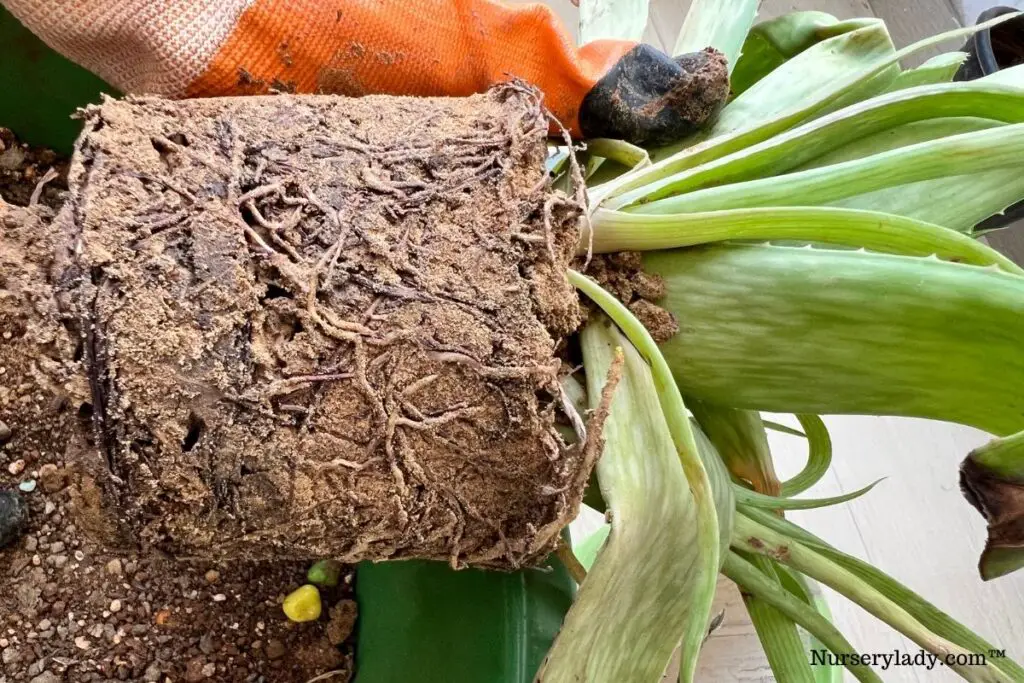
Root rot is a deadly fungal disease that damages your plant’s roots and mostly results from overwatering.
Other reasons for root rot may include poor draining soil or a pot with no drainage holes.
The curling leaves may be due to root rot if you have watered your Aloe vera too frequently without checking the soil.
In root rot, the Aloe vera leaves curl downwards.
There are many other signs of root rot, such as:
- Yellow leaves
- Brown leaves
- Foul-smelling soil
If you don’t treat root rot on time, all the roots of your Aloe vera will decay, and the plant will eventually die.
Solution:
If you suspect root rot, take your Aloe vera out of its pot or the garden, and inspect the roots.
- Prune all the soft and brown roots with a sharp and sterilized scissor.
- Spray fungicide on the healthy ones.
- Discard the old soil and plant the aloe vera in fresh soil and a new pot.
- For aloe veras growing in the garden, plant them at a different site after adding sand and perlite to the soil to ensure the excess water dries fast.
- Place the Aloe in a bright spot where it can get 6 hours of direct sunlight.
Diseases
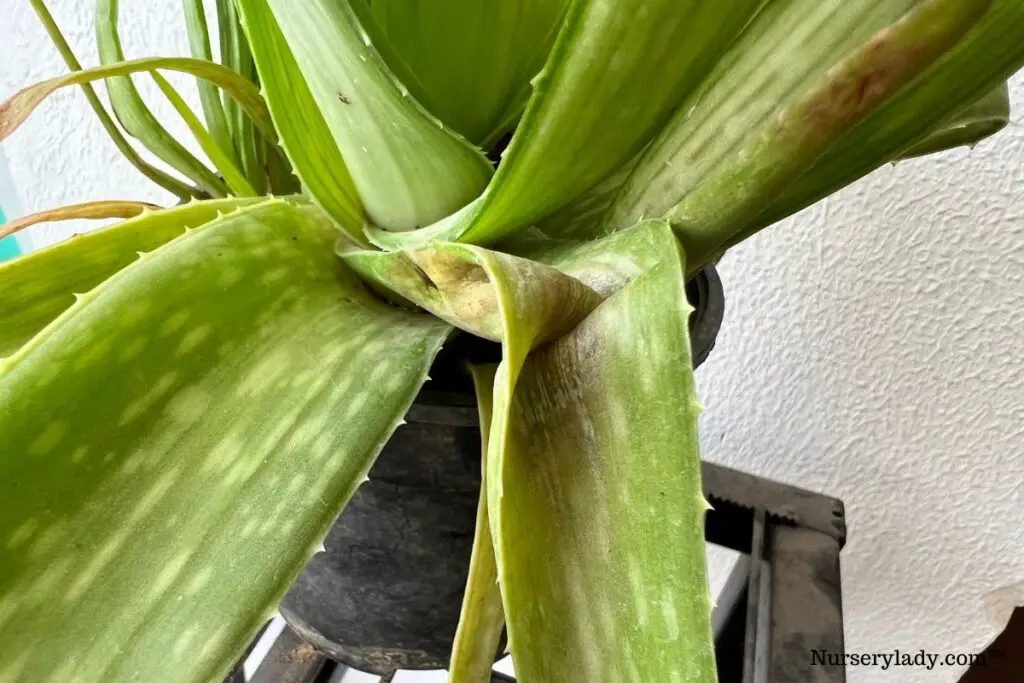
Most bacterial or fungal diseases occur in your Aloe vera due to overwatering.
We already discussed root rot but other diseases that can affect your Aloe vera and make the leaves curl are:
- Anthracnose
- Basal stem rot
- Bacterial soft rot
- Aloe rust
Most of these diseases are fatal and can kill your Aloe vera.
Solution:
- You can spray fungicide on your Aloe vera plant to treat these diseases.
- You must place the plant in a bright spot but not under the direct sun.
- After removing the affected parts, you can try repotting or transplanting the plant in fresh soil.
- But if your plant doesn’t get well, you will need to discard it.
- It is always better to prevent these diseases by not overwatering your Aloe vera, providing proper air circulation, and maintaining the ideal environment for the plant’s growth.
Can curled leaves go back to normal?
In rare cases, the curled leaves will become normal again.
After identifying what is wrong with your Aloe vera, start the treatment and check if the leaves are turning normal.
If not, you should prune the curled leaves.
This will allow your Aloe to focus on new and healthy growth.
Reference: NCBI, New York Botanical Garden, University of New Hampshire, University of Florida, Wikipedia.
